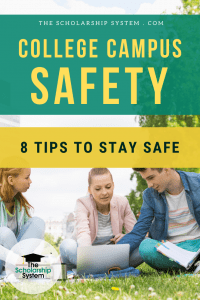Updated on August 29th, 2024
College campus safety is a priority for many. Parents want to know that their children are safe, and students want to feel secure in their school environment.
Reviewing campus crime statistics, which are reported annually in compliance with the Clery Act, is important. These statistics help students and parents assess crime trends and safety measures.
While colleges operate programs designed to maintain the safety of students, that doesn’t mean students shouldn’t also take action. By making smart choices, students can enhance safety on college campuses, ensuring they, as well as those around them, can be on the property without fear.
With that in mind, here are eight campus safety tips all students should embrace, as well as some additional information.
Looking for scholarships to help cut down on college costs? If you and your student want to learn more about finding scholarships for college, sign up for our free college scholarship webinar! Head over to to reserve your spot today.
Contents
- 1 8 College Campus Safety Tips
- 1.1 1. Don’t Get Sucked in by Technology
- 1.2 2. Use the Buddy System
- 1.3 3. Always Lock Your Room
- 1.4 4. Have a Plan in Case of Dorm Fires
- 1.5 5. Don’t Accept Drinks Poured by Someone Else
- 1.6 6. Keep Someone Informed of Your Whereabouts
- 1.7 7. Sign Up for Alerts and Download Campus Safety Apps
- 1.8 8. Have Personal Defense Options with You
- 2 Safety on College Campuses Statistics
- 3 How to Report College Campus Safety Issues
8 College Campus Safety Tips
1. Don’t Get Sucked in by Technology
While it may be funny to see someone walk into a fountain because they were nose-deep in their smartphone, being that unaware of one’s surroundings is dangerous. Whether it’s your student not watching as they walk around or your student not being able to hear because of their headphones, being that tuned out can put them at risk.
Make sure your student understands that a lack of situational awareness carries risks and is crucial for personal safety. Encourage them to keep their phone accessible, but to avoid focusing on the screen while they walk around. Also, remind them that keeping their audio volume reasonable is a good idea, as it increases the odds that they’ll be able to hear something that may signal a problem.
2. Use the Buddy System
When it comes to campus safety, being part of a group makes a difference. Students who are walking around the property alone, particularly at night, are more vulnerable.
Ideally, students should embrace the buddy system. By remaining in pairs or groups, no one is alone. That may decrease the odds that they will be targeted or, at least, ensure they have someone with them should something happen.
Students should also be aware of the role of campus police in responding to suspicious behaviors and ensuring security. It is crucial to know how to contact campus police in case of emergencies.
3. Always Lock Your Room
While a dorm lifestyle is usually relaxed, that doesn’t mean students shouldn’t lock their doors. It ensures their property is secure when they are away. Plus, if they are in their room, it makes it much harder for someone unwelcome to make their way inside. Campus security plays a crucial role in preventing unauthorized access to dorm rooms and ensuring the safety of students’ belongings.
Even if your student’s roommate is just running down the hall and coming back in a few minutes, it’s still best to lock the door. It’s a simple habit that can make a big difference.
4. Have a Plan in Case of Dorm Fires
Fire safety on campus is just as important as any other kind. If your student lives in a dorm, they need to have multiple options for exiting the building safely. That way, if fire blocks one path, they have others they can take.
Additionally, it’s wise to have certain items available, or at least know their location. For example, having a small fire extinguisher in their room can be a smart move (so consider adding one to your student’s dorm room checklist). Otherwise, learning where they are in the building is wise.
It can be a good idea to group critical personal items together by putting them in a basket or small box. Then, if a fire breaks out at night, your student knows exactly where their wallet, phone, keys, and similar items are and can just grab the basket or box and go.
5. Don’t Accept Drinks Poured by Someone Else
Though it may irk many parents, parties happen on college campuses. They can be great for students, allowing them to socialize, relax, or blow off steam. But they can also come with certain risks.
If your student attends a party, they should never take a drink that was poured by someone else, alcoholic or not, and alternately never leave their drink unattended. There may be no way to determine what is in that cup, and many debilitating drugs aren’t detectable by taste, color, or smell.
If your student feels off after drinking anything, they should immediately get help. Even if it’s just drunkenness, a student is much more vulnerable once they are inebriated, so they should seek assistance from someone they know and trust.
6. Keep Someone Informed of Your Whereabouts
When your student gets ready to head out, it’s best to let someone know where they are going and when they will return. Make sure trusted individuals know their class, work, or other standard schedules, and touch base regularly throughout the day. Programming emergency contacts into your cell phone and keeping them readily accessible can make a significant difference in emergencies, enhancing personal safety while navigating college life. This allows students to keep an eye out for one another and to take action if something seems amiss.
7. Sign Up for Alerts and Download Campus Safety Apps
Many schools offer text alerts to students that can send then emergency notifications letting them know of incidents. Through those programs, students will receive a message when they need to be aware of a safety issue. It keeps them informed and allows them to make better choices, including during active incidents and for general safety.
The Public Safety department plays a crucial role in managing emergency situations and addressing safety concerns, ensuring that students are well-protected on campus.
Additionally, colleges increasingly have their own campus safety apps. Many of these can connect directly with security offices during an emergency, sending officers a message and even a GPS location. Some also allow students to report incidents, making it easier to provide critical information that can keep their school safer.
8. Have Personal Defense Options with You
Carrying personal defense options is one of the many safety measures students can take to protect themselves. Pepper spray, loud whistles, and other non-lethal devices can be smart to keep on-hand as a college student. They may deter an attacker from proceeding, increase the odds that a bystander will come to a student’s aid, or put a halt to an assault.
Similarly, having some self-defense training can also be wise. It ensures your student knows what to do if someone attacks them, increasing the odds that they’ll take action and find a way to escape the situation.
Safety on College Campuses Statistics
Data about college campus safety is widely available due to the enactment of the Clery Act. It requires many schools to report their crime statistics, ensuring students can review the data and make smart choices about their education.
First and foremost, it’s essential to understand that, in many ways, college campuses are safer today than they were a decade or more ago. The college campus safety statistics show that total crime rates, as well as burglary and motor vehicle theft reports, have predominately declined since 2006. In total, on-campus crime rates fell by 32 percent between 2001 and 2016.
However, forcible sex offenses have risen. In 2016, there were 8,900 on-campus incidents across post-secondary institutions that participate in Title IV federal financial aid programs. That makes an occurrence rate of 6 per 10,000 full-time equivalent (FTE) students.
The numbers above are aggregated, based on data from the majority of colleges, including two- and four-year degree-granting institutions. For college campus safety statistics on individual schools, it’s best to check the U.S. Department of Education’s Campus Safety and Security database. There, you can find college campus safety data for individual institutions and compare multiple schools directly, ensuring your student can factor in that information when choosing a college.
How to Report College Campus Safety Issues
If your student notices any college campus safety issues, they have options. First, they can call 911 if they need police, fire, or medical assistance. Whether they are injured or feel that they are in danger, calling the local authorities is an approach that they can always use during an emergency.
For non-emergencies, students can also contact their campus safety and security offices. Those offices are traditionally open 24/7. Along with taking incident reports, hearing concerns, and actively patrolling the school property, campus safety escort services may also be available.
Some schools also maintain emergency call boxes. By pressing the call box button, the student is routed straight to the safety and security office. Plus, the call box typically has a light that will start flashing, allowing safety officers to locate students quickly.
Students should make sure that emergency phone numbers, including campus safety office lines, are programmed into their phones. Then, if they need immediate assistance, they won’t have to look up the number.
Looking for scholarships to help cut down on college costs? If you and your student want to learn more about finding scholarships for college, sign up for our free college scholarship webinar! Head over to https://thescholarshipsystem.com/freewebinar to reserve your spot today.








Preparing my kids to leave home. this is a great article with good tips.